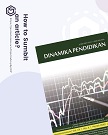Exploring Polytechnic Learners’ Perception on Multimodality in MALL in Business Administration Instruction
(1) State Polytechnic of Bali
(2) Universitas Pendidikan Ganesha
Abstract
This paper aimed to analyze Polytechnic learners’ perception of multimodality in Mobile-Assisted Language Learning (MALL) in an English instructional context. This research was a survey with a quantitative approach. Purposive sampling was employed and considered only for students who learned English language lessons at eight classes in the Business Administration Department, Politeknik Negeri Bali. Questionnaires focused on the Performance Expectancy (PE), Effort Expectancy (EE), and Behavior Intention (BI) of UTAUT theory. The result of the study indicated that internet technology was prevalent to be used by the students and there was a keen exploration of the English materials in a multimodal perspective that is a combination of technology-based learning materials with various modes, involving audiovisual, pictures, realia, in different formats. The usefulness of the device and the ease of technology used contribute to the use of mobile-assisted language learning (MALL) in learning the English language. The result also revealed the entrepreneur candidates tended to choose MALL with multimodal immersion as a fruitful combination to escalate their English language skills. Policies, subject matter expertise, appropriate pedagogies, and relevant use of technology support are suggested to explore the usefulness of MALL for students in Polytechnic education.
Keywords
Full Text:
PDFReferences
Abu Seileek, A. F. & Abu Sa’aleek, A. O. (2012). Computer assisted language learning: Merits and demerits. Language in India, 12(4), 23-36.
Ababneh, S. (2017). Using Mobile Phones in Learning English: The Case of Jordan. Journal of Education and Human Development, 6(4). https://doi.org/10.15640/jehd.v6n4a14
Alaidarous, K., & Madini, A. A. (2016). Exploring EFL students’ perception in blended learning environment in Saudi Technical Education context. International Journal of Educational Investigations, 3(6), 69–81.
Alotumi, M. (2020). EFL learning beyond the wall with MALL: College students' perceptions. In Enhancements and limitations to ICT-based informal language learning: Emerging research and opportunities (pp. 138-160). IGI Global.
Azar, A. S., & Nasiri, H. (2014). Learners’ attitudes toward the effectiveness of mobile-assisted language learning (MALL) in L2 listening comprehension. Procedia-Social and Behavioral Sciences, 98, 1836-1843. DOI: 10.1016/j.sbspro.2014.03.613.
Bryan, A., & Volchenkova, K. N. (2016). Blended Learning: Definition, Models, Implications for Higher Education. Bulletin of the South Ural State University Series “Education. Education Sciences,” 8(2), 24–30. https://doi.org/10.14529/ped160204
El-Hussein and Cronje, 2010, “Defining Mobile Learning in the Higher Education Landscape,” Educational Technology & Society, 13 (3), pp. 12– 21.
Gangaiamaran, R., & Pasupathi, M. (2017). Review on use of mobile apps for language learning. International Journal of Applied Engineering Research, 12(21), 11242–11251.
Hashemi, M., & Ghasemi, B. (2011). Using mobile phones in language learning/teaching. Procedia - Social and Behavioral Sciences, 15, 2947–2951. https://doi.org/10.1016/j.sbspro.2011.04.220
Işman, A. (2012). Technology and technique: An educational perspective. Turkish Online Journal of Educational Technology, 11(2), 207–213.
Jacqui, M. (2015). 13 Reasons for Using Technology in the Classroom. Retrieved from https://www.teachhub.com/13-reasons-using-technology-classroom
Kacetl, J., & Klímová, B. (2019). Use of smartphone applications in english language learning—A challenge for foreign language education. Education Sciences, 9(3), 1–9. https://doi.org/10.3390/educsci9030179
Kondalkar, V. G. (2007). Organizational behaviour. New Delhi: New Age International Pulishers.
Kress, G. (2019). Pedagogy as design: a social semiotic approach to learning as communication. Universitas Tarraconensis. Revista de Ciències de l’Educació, 1(2), 23. https://doi.org/10.17345/ute.2018.2.2488
Kress, G. (2010). Multimodality: A social semiotic approach to contemporary communication. Routledge. New York.
Kukulska-hulme, A. (2014). Open Research Online. Choice Reviews Online, 51(06), 51-2973-51–2973. https://doi.org/10.5860/choice.51-2973
Marchetti, L., & Cullen, P. (2015). A Multimodal Approach in the Classroom for Creative Learning and Teaching. Psychological and Creative Approaches to Language Teaching, 39–51. https://doi.org/10.1016/j.bbalip.2011.04.004
Mtega, P. Wulystan; Bernard, Ronald; Msungu, C. Andrew &Sanare, Rachel. (2012). Using Mobile Phones for Teaching and Learning Purposes in Higher Learning Institutions: The Case of Sokoine University of Agriculture in Tanzania. Proceedings and report of the 5th Ubuntu Net Alliance annual conference, 2012, pp. (118-129).
Muhammed, A. A. (2014). The Impact of Mobiles on Language Learning on the Part of English Foreign Language (EFL) University Students. Procedia - Social and Behavioral Sciences, 136, 104–108. https://doi.org/10.1016/j.sbspro.2014.05.297
Nuraeni, C., Carolina, I., Supriyatna, A., Widiati, W., & Bahri, S. (2020). Mobile-Assisted Language Learning (MALL): Students’ perception and problems towards mobile learning in English language. In Journal of Physics: Conference Series (Vol. 1641, No. 1, p. 012027). IOP Publishing.
Putra, M. A. M., & Santosa, M. H. (2020). Mobile assisted language learning in Intensive English Course for freshmen year students. Journal of Educational Technology, 4(2), 127–132. https://doi.org/http://dx.doi.org/10.23887/jet.v4i2.25097
Rahmanu, I. W. E. D., Altun, L., & Kariati, N. M. (2020). Critical Study on Multimodality Perception in Higher Education Classroom. Soshum: Jurnal Sosial dan Humaniora, 10(3), 260-270.
Rezaei, A., Mai, N., & Pesaranghader, A. (2014). The effect of mobile applications on English vocabulary acquisition. Jurnal Teknologi (Sciences and Engineering), 68(2), 73–83. https://doi.org/10.11113/jt.v68.2912
Robbins, S. P., & Judge, T. A. (2013). Organizational behavior (15th ed.): Boston: Pearson.
Rosado, A. &Khuttum, A. (2013). Student Attitudes Toward Using Facebook for Education: A Survey.Retrieved17-7-2017.From: http://www.google.com.sa/url?sa=t&rct=j&q=&esrc=s&frm=1&source=web&cd=1&ved= 6 m08Ofv7HKAhUGtRQKHWbjCJoQFggmMAA&url=http%3A%2F%2Fwww.nedsi.org%2Fproc%2F 2013%2Fproc%2Fp120928001 pdf&usg=AFQjCNFYvSPqLFjPXEwdLzpN_-AgRvSLRA.
Salameh, Zakariya. (2017). Attitudes Towards Facebook and the Use of Knowledge and Skills among Students in the English Department at the University of Hail. Journal of Education and Practice. 8(8), 1-6.
Sholihah, M., & Thoyib, M. E. (2020). Mobile-Assisted Language Learning: Utilizing A Smartphone to Learn English Vocabulary. INCARE, International Journal of Educational Resources, 1(4), 298-303.
Shyamlee, S., & Phil, M. (2012). Use of technology in English language teaching and learning: An analysis. A Paper Presented at the 2012 International Conference on Language, Medias and Culture IPEDR Vol.33 (2012) ©(2012) IACSIT Press, Singapore, 33(2012), 150–156. http://www.ipedr.com/vol33/030-ICLMC2012-L10042.pdf
Styaningrum, F., Sulistyowati, N., & Wibowo, A. (2021). Does Smartphone-Based Quizlet Affect Students Learning Interest? Dinamika Pendidikan, 16(1), 64-74. doi:https://doi.org/10.15294/dp.v16i1.28780
Sung, Y.-T., Chang, K.-E., & Yang, J.-M. (2015). How effective are mobile devices for language learning? A meta-analysis. Educational Research Review, 16, 68–84.
Tafazoli, D., Huertas Abril, C. A., & Gómez Parra, M. E. (2019). Technology-based review on Computer-Assisted Language Learning: A chronological perspective. Pixel-Bit.
Ulloa Salazar, G., & Díaz Larenas, C. (2018). Using an Audiovisual Materials-Based Teaching Strategy to Improve EFL Young Learners’ Understanding of Instructions. How, 25(2), 91–112. https://doi.org/10.19183/how.25.2.419
Venkatesh, V., Thong, J.Y., Xu, X., 2012. Consumer acceptance and use of information technology: extending the unified theory of acceptance and use of technology.
Venkatesh, V., Thong, J. Y. L., & Xu, X. (2016). Unified theory of acceptance and use of technology: A synthesis and the road ahead. Journal of the Association for Information Systems, 17(5), 328–376.
Wibawa, R., Astuti, R., & Pangestu, B. (2019). Smartphone-Based Application Quizizz as a Learning Media. Dinamika Pendidikan, 14(2), 244-253. doi:https://doi.org/10.15294/dp.v14i2.23359
Zhang, Y. (2016). The Impact of Mobile Learning on ESL Listening Comprehension. 3rd International Conference on Advanced Education and Management (ICAEM 2016). DOI: 10.12783/dtssehs/icaem2016/4290
Refbacks
- There are currently no refbacks.

This work is licensed under a Creative Commons Attribution 4.0 International License.

.png)

.png)





